An
abscess
is
a
collection
of
pus
resulting
from
an
infection
becoming
localized.
A
fistula
is
an
abnormal
communication,
like
a
tunnel,
between
two
epithelial
surfaces.
In
the
case
of
anal
fistulas,
between
the
anal
canal
and
the
surrounding
skin.

Figure
1:
Intersphincteric,
ischiorectal
abscess
and
trans
sphincteric
anal
fistula.
Note
the
internal
opening
ofthe
fistula
tract
is
just
above
the
dentate
line
where
the
anal
glands
drain
to.
Symptoms
of
abscess
Diagnosis
is
based
on
pain,
fever,
overlying
erythema
and
tenderness.
Occasionally
there
may
only
be
rectal
pain
with
the
abscess
then
diagnosed
on
rectal
examination.
However
the
pain
may
be
so
severe
that
this
examination
cannot
be
carried
out
and
examination
under
anaesthesia
is
required.
The
common
difficulty
is
in
distinguishing
this
from
an
anal
fissure
where
pain
prevents
examination.

1:
Peri
anal
abscess.
Starting
to
point.
Not
very
obvious
inflammatory
changes
but
as
not
very
large.
In
emergency
situation
e.g
no
beds
available,
remote
area,
could
be
drained
under
local
anaesthetic
in
the
office.
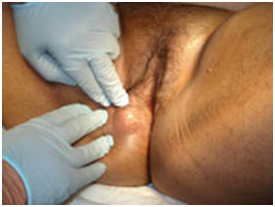
2.
Another
perianal
abscess.
It
is
not
an
infected
Bartholins
cyst
which
would
be
much
closer
and
within
vagina.
When
suitable
could
also
be
drained
in
office.
Appropriate
informed
consent
might
include
patient's
choice
of
venue.
Based
on
insurance
status,
bed
availability,
patients
pain
threshold,
health.
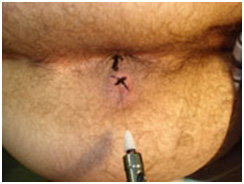
3.
The
abscess
and
site
of
incision
for
drainage
has
been
marked.
The
local
lignocaine
with
adrenaline
is
infiltrated
superficially.
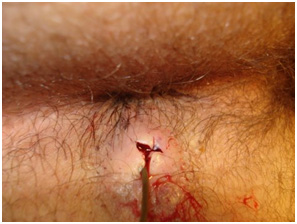
4.
The
cruciate
incision
has
been
made
to
drain
abscess.
Blood
appears
but
as
the
forceps
are
plunged
in,
blood
and
the
pus
discharges
with
a
gush.
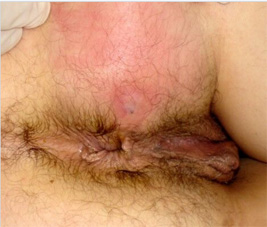
5.
The
ischiorectal
abscess
is
deeper
and
larger
usually
than
a
perianal
abscess
and
is
more
prone
to
cause
systemic
symptoms.
Treatment
of
abscess
Initially
antibiotics
are
often
used
but
once
an
abscess
develops
these
usually
only
contain
the
infection
rather
than
cure
it.
Antibiotics
may
partially
control
the
fever
and
also
the
spread
of
infection
into
the
general
circulation
-
septicemia.
Thus
surgical
treatment
and
drainage
is
required.
For
a
small
superficial
abscess
-
perianal
-
this
can
be
done
under
Local
Anaesthetic
in
the
surgeon's
office.
A
larger
abscess
such
as
an
ischiorectal
requires
hospitalisation
and
drainage
under
General
Anaesthesia.
At
surgery
an
incision,
which
may
be
cruciate
-
like
a
cross-
is
made
and
the
abscess
drained.
A
cruciate
incision
is
less
likely
to
heal
over
quickly
and
results
in
the
abscess
quickly
recurring.
Theoretically
the
abscess
should
be
cultured
for
antibiotic
sensitivities.
After
drainage
the
defect
is
packed
to
keep
the
wound
open
to
prevent
recurrence
and
bleeding.
The
dressing
may
be
removed
a
day
or
two
later;
baths
taken
and
repacked
gently
with
a
gradually
decreasing
sized
pack.
The
wound
is
allowed
to
heal
-
second
intention
healing.
There
may
be
no
further
problems,
but
in
up
to
30-50%
of
cases
a
fistula
will
result
as
the
internal
orifice
and
communication
persist.
Attempts
to
prevent
this
at
the
time
of
drainage
of
the
abscess
by
obliterating
the
internal
opening
are
frequently
unsuccessful
because
identification
is
difficult
because
of
the
oedema.
A
false
tract
may
also
result.
Attempts
to
prevent
a
fistula
may
result
in
incontinence
because
of
damage
to
the
sphincters.
.
Fistula
-
fistula
in
ano
An
anal
fistula
is
a
tunnel-like
tract
between
the
lining
of
the
anal
canal
and
the
skin
around
the
anus.
A
fistula
forms
usually
after
an
anal
abscess
has
drained
spontaneously
or
following
surgical
drainage.
Because
the
tract
is
lined
with
chronic
infection
it
tends
not
to
heal
and
there
is
a
persistent
discharge
of
pus.
This
may
settle
temporarily
with
or
without
antibiotics
but
then
recurs.
A
fistula
title
is
descriptive
of
its
position
in
relationship
to
the
sphincters
such
as
superficial
or
deep,
intersphincteric,
transsphincteric,
suprasphincteric.
The
higher
and
more
complex
the
fistula
the
more
difficult
to
treat.
Abscesses
and
fistulas
can
also
occur
in
association
with
other
conditions
such
as
inflammatory
bowel
disease
e.g.
Crohn's
disease
or
ulcerative
colitis.
The
management
of
these
is
quite
different.
Surgery
is
avoided.
When
a
fistula
is
present
the
clinician
should
think
of
the
possibility
of
underlying
Crohn's
disease.
For
complex
fistulas
endoanal
ultrasound
can
be
helpful
in
identifying
the
site
and
number
of
tracts.
Clinical
features
of
a
fistula
There
may
be
recurrent
staining
of
the
underwear
with
pus
or
blood.
The
patient
may
also
complain
of
pain
and
notice
a
lump.
Examination
shows
a
single
or
multiple
small
volcano
like
protrusions
with
established
fistulas.
A
little
like
a
keratoacanthoma
of
the
skin
with
its
central
core
plug
of
keratin.
These
are
at
variable
distances
from
the
anal
verge.
Palpation
may
discern
a
thickened
pencil
like
ridge
deep
to
the
skin
between
the
volcano
and
anal
canal.
Some
pus
can
often
be
expressed.
Rectal
examination
may
palpate
the
retracted
depressed
inner
opening
of
the
tract.
A
fistula
seldom
heals
spontaneously
permanently.
The
fistula
may
close
but
another
abscess
develops,
erupts
or
is
drained
.
There
are
a
variety
of
ways
of
treating
fistulas
depending
on
their
number,
size,
length,
complexity.
This
shows
the
type
of
steps
being
undertaken
to
improve
the
results
of
fistula
treatment
p.
Many
would
consider
it
experimental.
Exposing
the
fistula
opening
by
retracting
the
large
haemorrhoidal
tag
which
is
partially
obscuring
the
view.
This
fistula
is
discharging
close
to
the
anal
verge.
It
is
a
simple
superficial
fistula
which
can
readily
be
treated
by
fistulotomy.
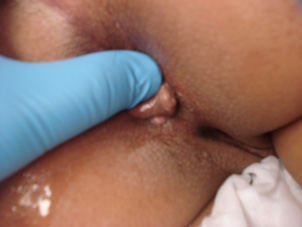
This
shows
the
pus
drainage
from
the
same
fistula
in
the
3
o'clock
position.
Notice
the
large
haemorrhoidal
tag.
The
gloved
finger
is
palpating
the
internal
orifice.
Although
it
appears
healed
it
can
readily
flare
up
forming
a
small
abscess
which
then
bursts.
.JPG)
Notice
surrounding
skin
rash.
The
discharging
sinus
in
the
6
o'clock
position
irritates
the
skin
thus
causing
a
rash.
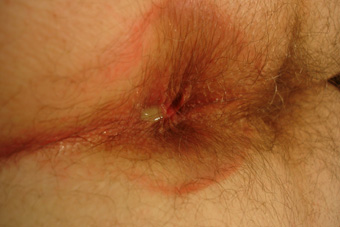
A
probe
is
inserted
into
a
tract
from
the
6
o'clock
position
before
performing
a
fistulotomy.
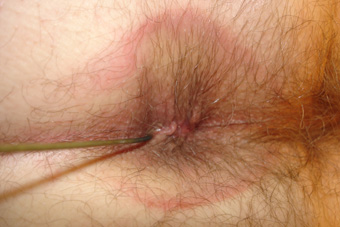
A
bridge
of
skin
has
grown
across
a
midline
posterior
fissure
to
form
a
superficial
fistulous
tract
in
the
midline
posterior.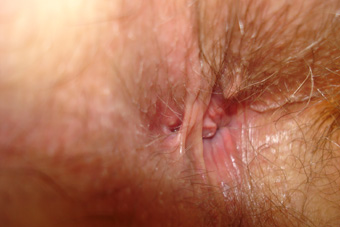
A
fistula
is
discharging
pus
in
the
3
o'clock
position
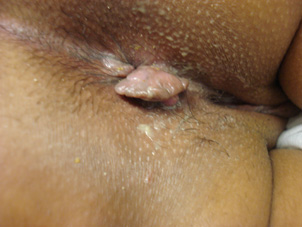
This
shows
that
there
is
no
further
discharge
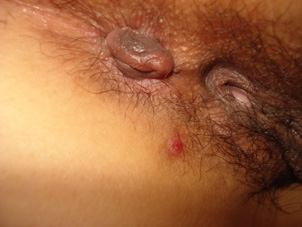
This
shows
the
tract
being
palpated
and
no
pus
protruding
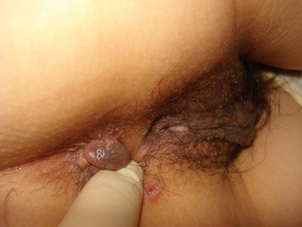
The
fistula
has
healed
temporarily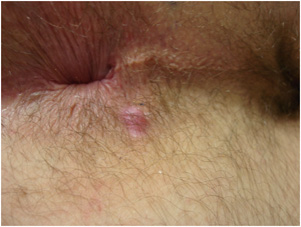
One
can
see
a
volcanic
like
eruption,
suggesting
a
fistula
has
not
healed
Fistulas
are
usually
readily
treated
surgically.
The
deeper
more
complex
ones
are
a
more
difficult
problem
as
attested
to
by
the
high
incidence
of
recurrence
and
the
number
of
alternative
more
recently
semi
surgical
methods
being
used
to
treat
them.
A
HIGH
DEGREE
OF
EXPERIENCE
AND
JUDGEMENT
IS
REQUIRED
Fistulotomy:
unroofing
the
fistula
Fistulectomy:
cutting
out
the
fistula,
not
advised
because
of
sphincter
damage.
A
General
Anaesthetic
is
usually
required.
A
fine
probe
is
manoeuvered
through
the
entire
length
of
the
tunnel
like
tract.
This
may
be
tricky
and
care
is
required
to
prevent
formation
of
a
false
tract.
Dye
(Evans
blue)
may
be
used
to
help
identify
the
tract
and
any
branches.
The
tract
is
completely
opened
up,
packed
and
allowed
to
heal
from
its
depths
by
what
is
termed
second
intention
healing.
This
process
does
take
some
time
and
cannot
be
hastened
by
suturing.
This
is
termed
laying
open
the
fistula
as
opposed
to
excising
the
fistula-fistulectomy
As
the
fistula
passes
through
the
muscle
this
muscle
has
to
be
divided.
This
makes
the
operation
a
little
tricky
because
there
is
a
risk
that
if
too
much
muscle
is
divided
there
can
be
permanent
incontinence
to
flatus,
fluid
or
faeces.
Thus
particular
care
is
required
with
this
procedure.
It
is
because
of
the
risk
of
incontinence
that
other
measures
are
undertaken.
These
include
setons,
glues
and
plugs.
Setons
A
loop
of
flexible
string
like
or
rubber
material
is
passed
through
the
tract
and
the
ends
tied
over
the
skin.
There
are
2
techniques
with
a
seton.
1-
draining
seton
This
is
tied
loosely
and
used
for
the
badly
infected
fistula
to
allow
drainage
and
an
operable
tract
to
later
develop.
2-
cutting
seton
This
is
tied
more
firmly.
The
idea
is
that
as
it
slowly
cuts
through
the
muscle
less
damage
is
done
allowing
regeneration
of
scar
tissue
and
less
damage
to
muscle.
A
mature
tract
may
develop
thus
allowing
fistulotomy.
With
time
this
may
cut
through
to
the
skin
as
it
is
further
tightened
and
permits
the
fistula
to
heal.
Fibrin
Glues
or
Plugs
They
are
injected
or
placed
into
the
tract.
These
do
not
cut
muscle
but
are
less
successful,
but
successful
in
some
cases.
They
have
the
advantage
of
not
burning
bridges
and
surgery
can
be
attempted
later.
LIFT
procedure:
Ligation
of
Of
Intersphincteric
Fistula
Tract
Some
consider
this
a
significant
development
in
the
management
of
fistulas.
It
involves
ligating
the
fistula
in
the
Intersphincteric
space,coring
out
the
fistula
from
internally
proximal
to
this,then
closing
the
internal
opening
The
VAAFT
technique
is
a
novel,
minimally
invasive
and
sphincter-sparing
technique
performed
for
the
surgical
treatment
of
complex
anal
fistulas
and
their
recurrences,
VAAFT
is
performed
under
direct
endoluminal
vision
and
allows
identification
of
the
internal
opening,
secondary
tracts
and
abscess
cavities
followed
by
endoluminal
management
of
the
fistula
tract,
and
finally
closure
of
the
internal
opening.
This
is
still
considered
experimental.
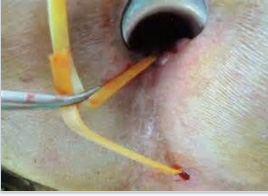
Seton
in
place
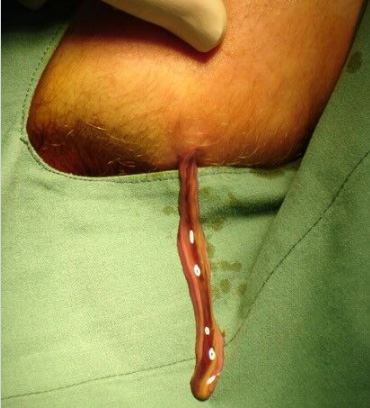
Draining
of
abscess
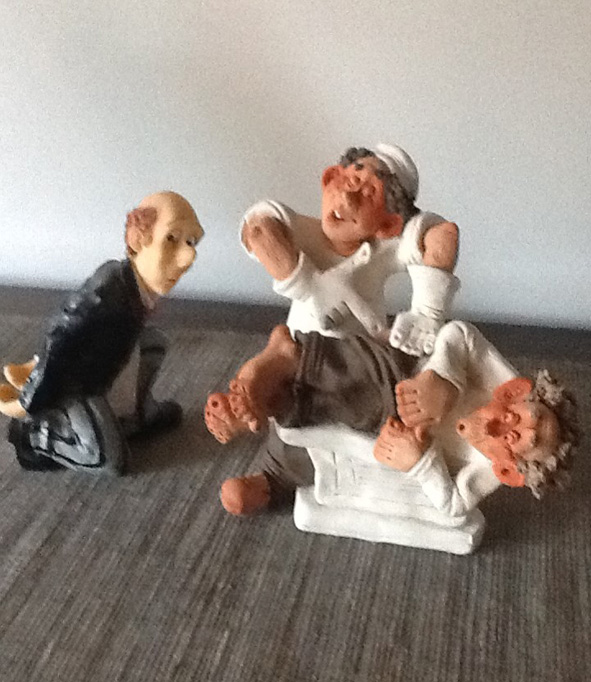
The
importance
of
the
message
of
this
figurine
is
that
it
shows
'if
you
do
not
put
your
finger
in
you
put
your
foot
in'.
This
means
if
you
don't
examine
the
patient
properly
you'll
have
problems.
The
other
figure
could
be
called
the
minister
of
health
or
the
medical
board
-
he
is
big
brother
looking
over
your
shoulder.
The
importance
is
that
the
anorectal
region
is
a
very
sensitive
area
and
the
patient
will
complain
if
it
is
not
adequately
treated
or
is
not
given
due
respect.
In
summary
we
are
carrying
out
this
series
of
programmes
to
familiarise
general
practitioners
with
the
current
diagnosis
and
treatment
of
ano
rectal
conditions.
Unfortunately
the
trainee
doctor
is
not
exposed
to
these
conditions
sufficiently
to
be
confident
in
their
management
however
this
program
is
an
attempt
to
improve
that
situation
by
stressing
how
important
it
is
to
take
a
history
and
do
the
adequate
examination.
One
of
the
positive
features
about
working
in
this
area
that
a
positive
diagnosis
can
usually
be
made
just
by
taking
a
history
and
simple
examination.
For
example
on
examination
of
the
Perianal
region
we
asked
the
patient
to
strain.
This
may
demonstrate
haemorrhoids
protruding.
In
addition
to
the
rectal
examination
we
would
hope
that
you
would
do
an
abdominal
examination
as
well.
We
have
attempted
to
provide
clinical
information
regarding
these
conditions
particularly
as
they
apply
to
the
general
practitioner.
The
management
of
Fistulas
is
complex
and
should
only
be
in
the
realm
of
an
experienced
surgeon
as
in
western
society
they
are
a
common
cause
of
litigation
should
incontinence
occur.
It
is
for
this
reason
before
embarking
on
the
surgery
a
comprehensive
informed
consent
is
required.
To
this
end
we
have
provided
illustrations
and
clinical
examples
mostly
from
the
author's
own
practice.
This
article
is
only
to
provide
information
rather
than
to
recommend
a
particular
form
of
treatment.
Further
information
is
available
on
www.hernia.net.au.
Melbourne
hernia
clinic
www.melbourne
haemorrhoid
and
rectal
bleeding
clinic

